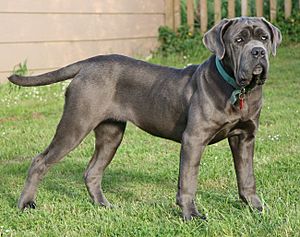Neapolitan Mastiff facts for kids
 |
||||||||||||||||||||||||||||||
| Other names | Mastino Mastino Napoletano Italian Molosso Can'e presa |
|||||||||||||||||||||||||||||
|---|---|---|---|---|---|---|---|---|---|---|---|---|---|---|---|---|---|---|---|---|---|---|---|---|---|---|---|---|---|---|
| Origin | Italy | |||||||||||||||||||||||||||||
|
||||||||||||||||||||||||||||||
|
||||||||||||||||||||||||||||||
| Domestic dog (Canis lupus familiaris) | ||||||||||||||||||||||||||||||
The Neapolitan Mastiff or Mastino (Italian: Mastino Napoletano) is a very large and old dog breed. These huge dogs are often used as guard dogs. They are known for protecting their family and home. This is because they have strong protective instincts and look quite fearsome!
Contents
What Does a Neapolitan Mastiff Look Like?
Neapolitan Mastiffs are big and strong dogs. Male dogs usually stand 26 to 31 inches (66 to 79 cm) tall at the shoulder. They can weigh between 130 and 155 pounds (60 to 70 kg). Female dogs are a bit smaller. They are usually 24 to 29 inches (61 to 74 cm) tall and weigh 110 to 130 pounds (50 to 60 kg). Their body length is a little longer than their height.
These dogs have loose skin all over their bodies. Their fur can be black, blue, mahogany (a reddish-brown), or tawny (a light brown).
Neapolitan Mastiff Personality and Behavior
Neapolitan Mastiffs are brave and very protective of their home and family. They love being close to their human family members. These dogs usually do not bark much unless they are really provoked. They are known for quietly approaching strangers instead of barking loudly to warn them.
This breed is very smart and can think for itself. They learn new things quickly. This can be both good and bad! Because they are natural guard dogs, they need a lot of early training. This helps them learn to accept new people, especially when those people visit their home. Without this training, they might act aggressively towards strangers or dogs they don't know.
It's very important to teach Neapolitan Mastiffs to be comfortable around people, especially children. They are large and powerful dogs and sometimes don't realize how strong they are. Young children often have friends over, and even with good training, these dogs will be cautious of strangers. They will also be protective of their family. Most of the time, they would even protect their owners with their lives.
You don't need to give them extra guard dog training. They are already born with strong protective instincts. Like all dogs, obedience training is very important for them. Neapolitan Mastiffs can handle a lot of pain. This is partly because of their loose skin. So, it's important to check them regularly for health problems. They might not show signs of being hurt or sick. They are also famous for drooling, especially after drinking water or when they get excited!
Neapolitan Mastiffs are not very active dogs, even when they are puppies. It's best to limit their visits to dog parks. This is because they can sometimes be aggressive towards other dogs they don't know. The best place for a Neapolitan Mastiff is a home with a big yard. The yard should have a fence that is five or six feet tall.
History of the Neapolitan Mastiff
The Neapolitan Mastiff belongs to a group of dogs called Molossers. These dogs likely came from a common ancestor. It's not fully clear if this ancestor was the ancient Molossus dog.
These types of dogs were popular in Europe for hundreds of years. But after World War II, there were very few left. After the war, an Italian painter named Piero Scanziani started a special breeding program. He wanted to turn the Mastiff-type dogs of Italy into a formal breed. This breed was then named the Neapolitan Mastiff. The English Mastiff breed was also used to help in this process.
See also
 In Spanish: Mastín napolitano para niños
In Spanish: Mastín napolitano para niños



